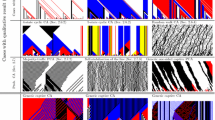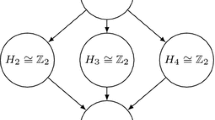Abstract
We study the dynamics of (synchronous) one-dimensional cellular automata with cyclical boundary conditions that evolve according to the majority rule with radius r. We introduce a notion that we term cell stability with which we express the structure of the possible configurations that could emerge in this setting. Our main finding is that apart from the configurations of the form \( (0^{r+1}0^* + 1^{r+1}1^*)^* \), which are always fixed-points, the other configurations that the automata could possibly converge to, which are known to be either fixed-points or 2-cycles, have a particular spatially periodic structure. Namely, each of these configurations is of the form \( s^* \) where s consists of \( O(r^2) \) consecutive sequences of cells with the same state, each such sequence is of length at most r, and the total length of s is \( O(r^2) \) as well. We show that an analogous result also holds for the minority rule.
Access this chapter
Tax calculation will be finalised at checkout
Purchases are for personal use only
Similar content being viewed by others
Notes
- 1.
In this work, a state is a value in \( \{0,1\}\).
- 2.
Which can be shown to be at most linear in n [10].
- 3.
Indeed, it is shown in [14] that the probability that a randomly selected configuration of length n being transient approaches 1 as \( n \longrightarrow \infty \). As such, the additional temporally periodic configurations that we address in this work are, in a sense, not “typical”. We, in contrast to [14], make no assumption about the distribution of the configuration space, and are therefore interested in understanding the structure of all configurations, not only the “typical” ones.
- 4.
e.g., for \( r=3 \), the transient configuration 001001001001001001 converges after one step to the fixed-point configuration \( (0)^* \).
- 5.
e.g., for \( r=4 \), the transient configuration 001011001011001011001011001011001011 converges after one step to the 2 cycle consisting of \( (111000)^6 \) and \( (000111)^6 \).
- 6.
Also \( (10)^* \), but since the configurations are cyclic, the patterns \( (01)^* \) and \( (10)^* \) correspond to equivalent sets of configurations.
- 7.
The string s could also be the mirror or the complement of any of the specified patterns, which we omit for the sake of conciseness. For example, since we explicitly specified that s could be 010011, it means that s could also be 110010 (which is the mirror of 010011) or 101100 (which is the complement of 010011), even though these two are not explicitly specified.
- 8.
The middle block is well defined, as it is shown in the full version [10] that the number of blocks between I and J must be odd.
- 9.
In the dominance problem, one asks how many cells must initially be at a certain state so that eventually all cells have the same state.
References
Balogh, J., Bollobás, B., Duminil-Copin, H., Morris, R.: The sharp threshold for bootstrap percolation in all dimensions. Trans. Am. Math. Soc. 364(5), 2667–2701 (2012)
Flocchini, P., Královič, R., Ružička, P., Roncato, A., Santoro, N.: On time versus size for monotone dynamic monopolies in regular topologies. J. Discrete Algorithms 1(2), 129–150 (2003)
Fogelman, F., Goles, E., Weisbuch, G.: Transient length in sequential iteration of threshold functions. Discret. Appl. Math. 6(1), 95–98 (1983)
Frischknecht, S., Keller, B., Wattenhofer, R.: Convergence in (social) influence networks. In: Afek, Y. (ed.) DISC 2013. LNCS, vol. 8205, pp. 433–446. Springer, Heidelberg (2013). https://doi.org/10.1007/978-3-642-41527-2_30
Gärtner, B., Zehmakan, A.N.: Majority model on random regular graphs. In: Bender, M.A., Farach-Colton, M., Mosteiro, M.A. (eds.) LATIN 2018. LNCS, vol. 10807, pp. 572–583. Springer, Cham (2018). https://doi.org/10.1007/978-3-319-77404-6_42
Gärtner, B., Zehmakan, A.N.: Majority rule cellular automata. Theoret. Comput. Sci. 889, 41–59 (2021)
Goles, E., Martinez, S.: Neural and Automata Networks: Dynamical Behavior and Applications, vol. 58. Springer, Cham (2013). https://doi.org/10.1007/978-94-009-0529-0
Goles, E., Olivos, J.: Comportement périodique des fonctions à seuil binaires et applications. Discret. Appl. Math. 3(2), 93–105 (1981)
Mitsche, D., Pérez-Giménez, X., Prałat, P.: Strong-majority bootstrap percolation on regular graphs with low dissemination threshold. Stoch. Process. Their Appl. 127(9), 3110–3134 (2017)
Nakar, Y., Ron, D.: The structure of configurations in one-dimensional majority cellular automata: from cell stability to configuration periodicity. arXiv preprint arXiv:2205.08972 (2022)
Papp, P.A., Wattenhofer, R.: Stabilization time in minority processes. arXiv preprint arXiv:1907.02131 (2019)
Peleg, D.: Local majorities, coalitions and monopolies in graphs: a review. Theor. Comput. Sci. 282(2), 231–257 (2002)
Poljak, S., Sura, M.: On periodical behaviour in societies with symmetric influences. Combinatorica 3(1), 119–121 (1983)
Tosic, P.T., Agha, G.A.: Characterizing configuration spaces of simple threshold cellular automata. In: Sloot, P.M.A., Chopard, B., Hoekstra, A.G. (eds.) ACRI 2004. LNCS, vol. 3305, pp. 861–870. Springer, Heidelberg (2004). https://doi.org/10.1007/978-3-540-30479-1_89
Tošic, P.T., Raju, S.N.: On convergence properties of one-dimensional cellular automata with majority cell update rule. In: Proceedings of International Conference on Scientific Computing, pp. 308–314 (2011)
Turau, V.: Fixed points and 2-cycles of synchronous dynamic coloring processes on trees. arXiv preprint arXiv:2202.01580 (2022)
Zehmakan, A.N.: On the spread of information through graphs. Ph.D. thesis, ETH Zurich (2019)
Zehmakan, A.N.: Opinion forming in Erdős-Rényi random graph and expanders. Discret. Appl. Math. 277, 280–290 (2020)
Author information
Authors and Affiliations
Corresponding author
Editor information
Editors and Affiliations
Rights and permissions
Copyright information
© 2022 The Author(s), under exclusive license to Springer Nature Switzerland AG
About this paper
Cite this paper
Nakar, Y., Ron, D. (2022). The Structure of Configurations in One-Dimensional Majority Cellular Automata: From Cell Stability to Configuration Periodicity. In: Chopard, B., Bandini, S., Dennunzio, A., Arabi Haddad, M. (eds) Cellular Automata. ACRI 2022. Lecture Notes in Computer Science, vol 13402. Springer, Cham. https://doi.org/10.1007/978-3-031-14926-9_6
Download citation
DOI: https://doi.org/10.1007/978-3-031-14926-9_6
Published:
Publisher Name: Springer, Cham
Print ISBN: 978-3-031-14925-2
Online ISBN: 978-3-031-14926-9
eBook Packages: Computer ScienceComputer Science (R0)




